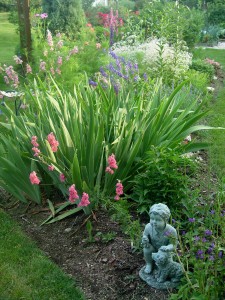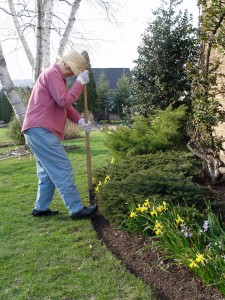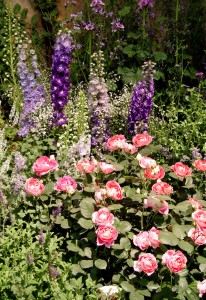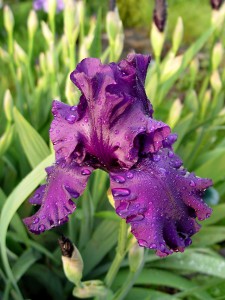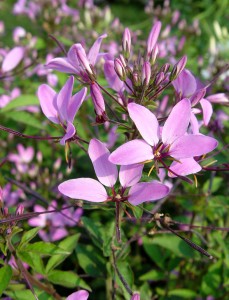Nurturing the Gardening Gene
May 11th, 2006
I’ve met a lot of superb gardeners.
One thing they all seem to have in common – besides a compost pile – is a close relative that ignited a love of gardening in them.
Sometimes it’s a plant-nut dad, but more often, it’s a mother or grandmother.
The spark doesn’t usually ignite directly.
It’s almost like there’s some kind of temporarily dormant gardening gene that gets passed along by osmosis, probably while we’re a teen-ager moaning about having to pull weeds or rake leaves.
The gene ferments for years until we have our own kids or hit fortysomething… then one day it bubbles out.
Next thing we know, weeding is suddenly a pleasant memory, and we’re planting dwarf lilacs and paying more attention to rock gardens than rock groups.
It’s no wonder I’m hopelessly addicted to the scent of freshly turned compost and the seduction of yet one more new tomato variety.
My whole family is crawling with people who got down and dirty.
My roots literally are all about roots.
I didn’t know my grandfather very well – he died of asthma when I was little more than a toddler – but I do remember his sprawling, half-acre vegetable rectangle next to the alley out back.
It was the consummate Victory Garden. Grandpa would hoe between the long, straight rows, dig up potatoes like hidden Easter eggs, and shake a big burlap bag to scatter pest-repelling limestone dust over the plants.
My dad was more a tomato and fruit-tree guy, but what I remember most about his gardening is the constant battle with the groundhogs and rabbits. Groundhogs would even climb our trees to eat the ripening peaches.
To this day, I have no affinity for rabbits, voles and especially groundhogs. If I ever get appointed to the United Nations, my first action will be to propose voting groundhogs off the planet.
My grandfather-in-law, Pappy Wetzel, made a career out of caring for a fruit-tree orchard in Adams County, and Grandma Wetzel was big-time into all sorts of flowers, both wild and cultivated.
Grandma Wetzel had this loosely designed flower bed (OK, she just stuck in whatever she liked wherever there was space) that was filled with all the classics – big, white Shasta daisies, old-fashioned bearded iris, a couple of roses, even a few cherry tomato plants in cages.
It definitely wasn’t a candidate for the cover of Fine Gardening, but she had a great time with it.
After Grandma Wetzel died, my wife and I added a garden to our back yard that we call “Grandma’s Garden.”
It’s designed in Grandmallian style with a little of this and a little of that, including a few offspring imported from the original Grandma’s Garden.
There’s a clump of velvety deep-purple bearded iris with petals so rich and smooth that they look like a king’s satin robe. Another iris blooms in the truest blue of any plant in the yard.
Pink and white spider flowers (cleome) and purple, pink and blue larkspur self-seed in patches every summer, and we’ve scattered in a couple of pink roses, a few fragrant lavenders, a few purple coneflowers, a puffy white baby’s breath and a patch of classic rosy-white ‘Star Gazer’ lilies that make great cut flowers (when we can bear to sacrifice them from the garden).
The only stipulation is that all plants must be Grandma plants.
I can imagine Grandma Wetzel sitting on our garden swing, smiling approvingly at this garden that some would consider to be one step shy of a jumbled mess.
No matter. There’s something to be said for the classics and a little “free-style” planting.
Big sweeps of today’s high-octane hybrids may look impressive in the landscape, but sometimes there’s a contrived or almost sanitary feel to these professionalistic beds.
Something seems to be missing.
I think it’s the charm.
Or maybe the nostalgia.
Or maybe it’s the love and satisfaction that goes along with the poke-it-in-as-you-go approach.
My own mom likes just about anything that grows – classic or otherwise. She’s just as happy with the first little ripe heirloom tomato of the season as she is with the new-fangled annual flowers that I test-grow every season.
But believe it or not, in her younger days, she’d just as soon be in a bed of weeds as anywhere.
She loved pulling weeds.
Give her a 5-gallon bucket, a skinny trowel and a stool, and she was as happy as a groundhog in a peach tree.
To tell you the truth, I don’t really mind weeding either. Maybe I inherited the weeding gene.
But I really think it’s more a matter that weeding just gives an obsessed gardener a good excuse to be in the garden, face-to-face with the awesome variety of beauty and detail that The Great Grower has provided for us.
It’s funny how many younger people say they really have no taste for gardening because they got stuck with the weeding when they were kids.
Then time advances, and that long-dormant garden gene emerges.
Before we know it – as in so many other facets of life – we realize we’re a lot more like Mom and Dad and Grandma and Grandpa than we ever would care to admit.
Some classic “Grandma Garden” plants worth returning to a garden near you…
SHRUBS
Bayberry
Beautybush
Boxwood
Clethra
Daphne
Deciduous (Flame) azaleas
Deutzia
Flowering quince
Fothergilla
Forsythia
Honeysuckle
Hydrangea
Juniper
Lilac
Mock orange
Rhododendron
Roses
Snowberry
Spirea
Star magnolia
Sweetshrub
Viburnum
Weigela
Witch hazel
Yew
PERENNIALS
Asters
Balloon flowers
Beebalm (Monarda)
Bellflower (Campanula)
Blazing star (Liatris)
Bleeding heart
Columbine
Coneflowers
Daylilies
Evening primrose
Gaillardia
Goldenrod
Hollyhocks
Hosta
Iris
Jacob’s ladder
Jupiter’s beard
Lance-leaf coreopsis
Lavender
Lilies
Mullein (Verbascum)
Peonies
Penstemon
Pinks (Dianthus)
Phlox
Poppies
Shasta daisy
Speedwell (Veronica)
Spiderwort
Yarrow
ANNUALS
Ageratum
Alyssum
Celosia
Cleome
Coleus
Dahlias
Geraniums
Gomphrena
Heliotrope
Larkspur
Marigolds
Nasturtiums
Nicotiana
Petunia
Portulaca
Salvia
Sunflowers
Snapdragons
Sweet peas
Verbena








